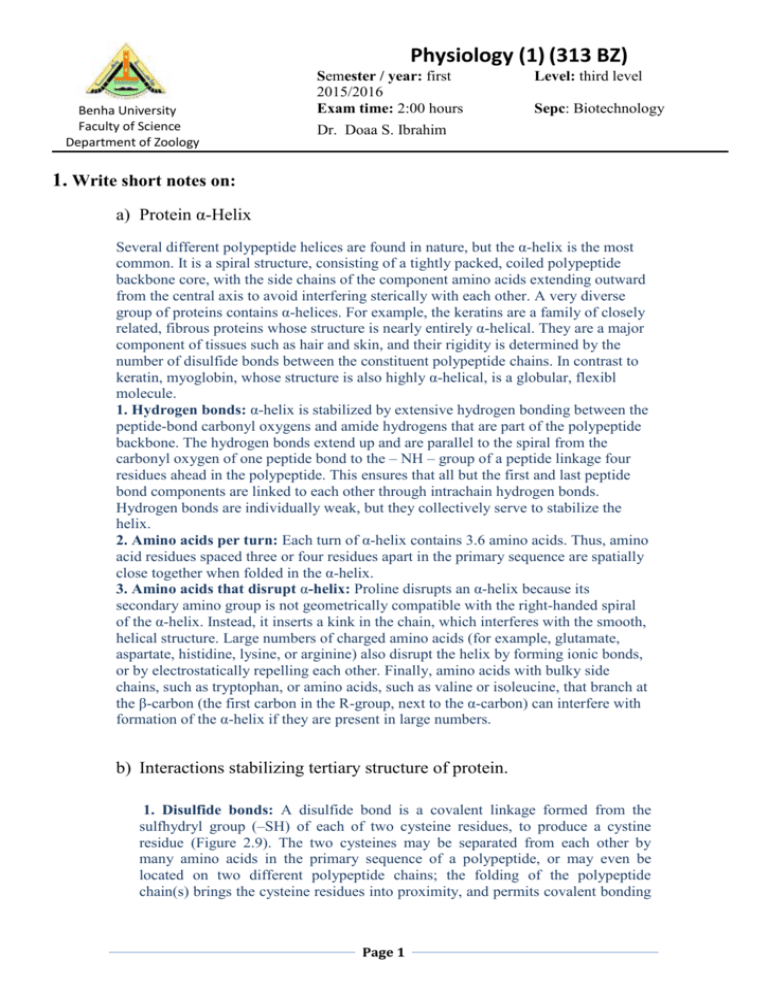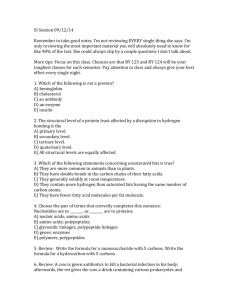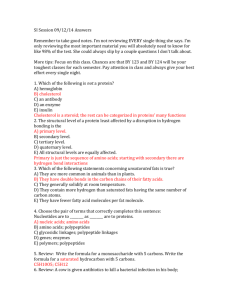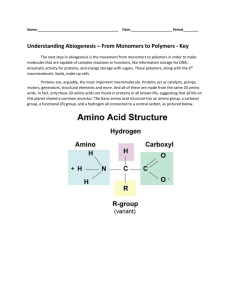1. Write short notes on
advertisement

Physiology (1) (313 BZ) Benha University Faculty of Science Department of Zoology Semester / year: first 2015/2016 Exam time: 2:00 hours Dr. Doaa S. Ibrahim Level: third level Sepc: Biotechnology 1. Write short notes on: a) Protein α-Helix Several different polypeptide helices are found in nature, but the α-helix is the most common. It is a spiral structure, consisting of a tightly packed, coiled polypeptide backbone core, with the side chains of the component amino acids extending outward from the central axis to avoid interfering sterically with each other. A very diverse group of proteins contains α-helices. For example, the keratins are a family of closely related, fibrous proteins whose structure is nearly entirely α-helical. They are a major component of tissues such as hair and skin, and their rigidity is determined by the number of disulfide bonds between the constituent polypeptide chains. In contrast to keratin, myoglobin, whose structure is also highly α-helical, is a globular, flexibl molecule. 1. Hydrogen bonds: α-helix is stabilized by extensive hydrogen bonding between the peptide-bond carbonyl oxygens and amide hydrogens that are part of the polypeptide backbone. The hydrogen bonds extend up and are parallel to the spiral from the carbonyl oxygen of one peptide bond to the – NH – group of a peptide linkage four residues ahead in the polypeptide. This ensures that all but the first and last peptide bond components are linked to each other through intrachain hydrogen bonds. Hydrogen bonds are individually weak, but they collectively serve to stabilize the helix. 2. Amino acids per turn: Each turn of α-helix contains 3.6 amino acids. Thus, amino acid residues spaced three or four residues apart in the primary sequence are spatially close together when folded in the α-helix. 3. Amino acids that disrupt α-helix: Proline disrupts an α-helix because its secondary amino group is not geometrically compatible with the right-handed spiral of the α-helix. Instead, it inserts a kink in the chain, which interferes with the smooth, helical structure. Large numbers of charged amino acids (for example, glutamate, aspartate, histidine, lysine, or arginine) also disrupt the helix by forming ionic bonds, or by electrostatically repelling each other. Finally, amino acids with bulky side chains, such as tryptophan, or amino acids, such as valine or isoleucine, that branch at the β-carbon (the first carbon in the R-group, next to the α-carbon) can interfere with formation of the α-helix if they are present in large numbers. b) Interactions stabilizing tertiary structure of protein. 1. Disulfide bonds: A disulfide bond is a covalent linkage formed from the sulfhydryl group (–SH) of each of two cysteine residues, to produce a cystine residue (Figure 2.9). The two cysteines may be separated from each other by many amino acids in the primary sequence of a polypeptide, or may even be located on two different polypeptide chains; the folding of the polypeptide chain(s) brings the cysteine residues into proximity, and permits covalent bonding Page 1 Physiology (1) (313 BZ) Benha University Faculty of Science Department of Zoology Semester / year: first 2015/2016 Exam time: 2:00 hours Dr. Doaa S. Ibrahim Level: third level Sepc: Biotechnology of their side chains. A disulfide bond contributes to the stability of the threedimensional shape of the protein molecule, and prevents it from becoming denatured in the extracellular environment. For example, many disulfide bonds are found in proteins such as immunoglobulins that are secreted by cells. 2. Hydrophobic interactions: Amino acids with nonpolar side chains tend to be located in the interior of the polypeptide molecule, where they associate with other hydrophobic amino acids. In contrast, amino acids with polar or charged side chains tend to be located on the surface of the molecule in contact with the polar solvent. In each case, a segregation of R-groups occurs that is energetically most favorable. 3. Hydrogen bonds: Amino acid side chains containing oxygen- or nitrogen-bound hydrogen, such as in the alcohol groups of serine and threonine, can form hydrogen bonds with electron-rich atoms, such as the oxygen of a carboxyl group or carbonyl group of a peptide bond. Formation of hydrogen bonds between polar groups on the surface of proteins and the aqueous solvent enhances the solubility of the protein. 4. Ionic interactions: Negatively charged groups, such as the carboxylate group (– COO–) in the side chain of aspartate or glutamate, can interact with positively charged groups, such as the amino group (– NH3+) in the side chain of lysine c) Role of chaperones in protein folding. It is generally accepted that the information needed for correct protein folding is contained in the primary structure of the polypeptide. Given that premise, it is difficult to explain why most proteins when denatured do not resume their native conformations under favorable environmental conditions. One answer to this problem is that a protein begins to fold in stages during its synthesis, rather than waiting for synthesis of the entire chain to be totally completed. This limits competing folding configurations made available by longer stretches of nascent peptide. In addition, a specialized group of proteins, named “chaperones,” are required for the proper folding of many species of proteins. The chaperones—also known as “heat shock” proteins— interact with the polypeptide at various stages during the folding process. Some chaperones are important in keeping the protein unfolded until its synthesis is finished, or act as catalysts by increasing the rates of the final stages in the folding process. Others protect proteins as they fold so that their vulnerable, exposed regions do not become tangled in unproductive interactions. Page 2








